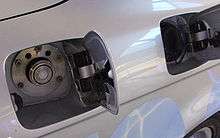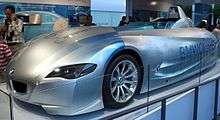Hydrogen internal combustion engine vehicle




A hydrogen internal combustion engine vehicle (HICEV) is a type of hydrogen vehicle using an internal combustion engine.[1] Hydrogen internal combustion engine vehicles are different from hydrogen fuel cell vehicles (which use electrochemical conversion of hydrogen rather than combustion); the hydrogen internal combustion engine is simply a modified version of the traditional gasoline-powered internal combustion engine.[2]
History
Francois Isaac de Rivaz designed in 1806 the De Rivaz engine, the first internal combustion engine, which ran on a hydrogen/oxygen mixture.[3] Étienne Lenoir produced the Hippomobile in 1863. Paul Dieges patented in 1970 a modification to internal combustion engines which allowed a gasoline-powered engine to run on hydrogen.[4]
Tokyo City University have been developing hydrogen internal combustion engine from 1970.[5] Recently developed hydrogen fueled Bus[6] and Truck.
Mazda has developed Wankel engines that burn hydrogen. The advantage of using ICE (internal combustion engine) such as wankel and piston engines is that the cost of retooling for production is much lower. Existing-technology ICE can still be used to solve those problems where fuel cells are not a viable solution as yet, for example in cold-weather applications.
Between 2005 - 2007, BMW tested a luxury car named the BMW Hydrogen 7, powered by a hydrogen ICE, which achieved 301 km/h (187 mph) in tests. At least two of these concepts have been manufactured.
HICE forklift trucks have been demonstrated [7] based on converted diesel internal combustion engines with direct injection.[8]
Alset GmbH developed a hybrid hydrogen systems that allows vehicle to use petrol and hydrogen fuels individually or at the same time with an internal combustion engine. This technology was used with Aston Martin Rapide S during the 24 Hours Nürburgring race. The Rapide S was the first vehicle to finish the race with hydrogen technology.[9]
Low emissions
The combustion of hydrogen with oxygen produces water as its only product:
- 2H2 + O2 → 2H2O
In contrast, combustion of high temperature combustion fuels, such as kerosene, gasoline, or natural gas, with air can produce oxides of nitrogen, known as NOx. Tuning a hydrogen engine in 1976 to produce the greatest amount of emissions possible resulted in emissions comparable with consumer operated gasoline engines from 1976. [10]
- H2 + O2 + N2 → H2O + NOx
Adaptation of existing engines
The differences between a hydrogen ICE and a traditional gasoline engine include hardened valves and valve seats, stronger connecting rods, non-platinum tipped spark plugs, a higher voltage ignition coil, fuel injectors designed for a gas instead of a liquid, larger crankshaft damper, stronger head gasket material, modified (for supercharger) intake manifold, positive pressure supercharger, and a high temperature engine oil. All modifications would amount to about one point five times (1.5) the current cost of a gasoline engine.[11] These hydrogen engines burn fuel in the same manner that gasoline engines do.
The theoretical maximum power output from a hydrogen engine depends on the air/fuel ratio and fuel injection method used. The stoichiometric air/fuel ratio for hydrogen is 34:1. At this air/fuel ratio, hydrogen will displace 29% of the combustion chamber leaving only 71% for the air. As a result, the energy content of this mixture will be less than it would be if the fuel were gasoline. Since both the carbureted and port injection methods mix the fuel and air prior to it entering the combustion chamber, these systems limit the maximum theoretical power obtainable to approximately 85% of that of gasoline engines. For direct injection systems, which mix the fuel with the air after the intake valve has closed (and thus the combustion chamber has 100% air), the maximum output of the engine can be approximately 15% higher than that for gasoline engines.
Therefore, depending on how the fuel is metered, the maximum output for a hydrogen engine can be either 15% higher or 15% less than that of gasoline if a stoichiometric air/fuel ratio is used. However, at a stoichiometric air/fuel ratio, the combustion temperature is very high and as a result it will form a large amount of nitrogen oxides (NOx), which is a criteria pollutant. Since one of the reasons for using hydrogen is low exhaust emissions, hydrogen engines are not normally designed to run at a stoichiometric air/fuel ratio.
Typically hydrogen engines are designed to use about twice as much air as theoretically required for complete combustion. At this air/fuel ratio, the formation of NOx is reduced to near zero. Unfortunately, this also reduces the power output to about half that of a similarly sized gasoline engine. To make up for the power loss, hydrogen engines are usually larger than gasoline engines, and/or are equipped with turbochargers or superchargers. [12]
See also
References
- ↑ INL-Hydrogen internal combustion engine vehicles
- ↑ "Hydrogen Use in Internal Combustion Engines" (PDF). US Department of Engergy. December 2001. Retrieved 25 July 2017.

- ↑ Eckermann, Erik (2001). World History of the Automobile. Warrendale, PA: Society of Automotive Engineers. ISBN 0-7680-0800-X.
- ↑ US 3844262
- ↑ Furuhama, Shouichi (1978). International Journal of Hydrogen Energy Volume 3, Issue 1, 1978, Pages 61–81. Elsevier Ltd.
- ↑ Hydrogen Fuel ICE Bus developed by TCU
- ↑ Linde X39
- ↑ HyICE
- ↑ de Paula, Matthew. "Aston Martin Favors Hydrogen Over Hybrids, At Least For Now". Forbes. Forbes Publishing.
- ↑ P.C.T. De Boera, W.J. McLeana and H.S. Homana (1976). "Performance and emissions of hydrogen fueled internal combustion engines". International Journal of Hydrogen Energy. 1 (2): 153–172. doi:10.1016/0360-3199(76)90068-9.
- ↑ Converting of gasoline ICE to hydrogen ICE
- ↑ Hydrogen use in internal combustion engines Archived 2011-09-05 at the Wayback Machine.
External links
| Wikimedia Commons has media related to Hydrogen internal combustion engine vehicle. |